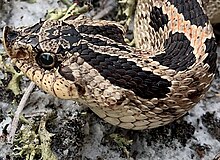Southern hognose snake
| Southern hognose snake | |
|---|---|

| |
| Adult southern hog-nosed snake | |

| |
| Red phase southern hog-nosed snake | |
| Scientific classification | |
| Domain: | Eukaryota |
| Kingdom: | Animalia |
| Phylum: | Chordata |
| Class: | Reptilia |
| Order: | Squamata |
| Suborder: | Serpentes |
| Family: | Colubridae |
| Genus: | Heterodon |
| Species: | H. simus
|
| Binomial name | |
| Heterodon simus (Linnaeus, 1766)
| |
| Synonyms | |

Heterodon simus, commonly known as the southern hog-nosed snake, is a harmless[4] snake species endemic to the southeastern United States. No subspecies are currently recognized.[5]
Description
Adults are 35.5–61 cm (14-24 inches) in total length. Stout with a wide neck and a sharply upturned snout, they usually have 25 rows of keeled dorsal scales at midbody.[6]
The
Habitat
The native habitats of Heterodon simus are xeric grasslands such as longleaf pine sandhill, upland pine forest, and scrubby flatwoods. In some areas, populations persist in mosaics of overgrown pastures, dry river floodplains, fields, and pine plantation.
Geographic range
The Southern hognose snake is found on the coastal plain of the southeastern United States from North Carolina, south to Lake Okeechobee in Florida, and west to Mississippi.[6]
Diet
Heterodon simus
Reproduction
This species is
Conservation status
This species is classified as Vulnerable (VU) on the
References
- . Retrieved 20 November 2021.
- ^ "NatureServe Explorer 2.0 - Heterodon simus Southern Hog-nosed Snake". explorer.natureserve.org. Retrieved 16 October 2020.
- Stejneger, L.H., and T. Barbour. 1917. A Check List of North American Amphibians and Reptiles. Harvard University Press. Cambridge, Massachusetts. 125 pp. (Heterodon simus, p. 77.)
- ^ "Southern Hognose Snake". The Wildlife Society - Florida Chapter. Retrieved 13 December 2020.
- ^ "Heterodon simus". Integrated Taxonomic Information System. Retrieved 14 September 2007.
- ^ ISBN 0-394-50824-6.
- ^ Wright, A.H., and A.A. Wright. 1957. Handbook of Snakes of the United States and Canada. Comstock. Ithaca and London. 1,105 pp. (in 2 volumes) (Heterodon simus, pp. 312-314, Figure 96. + Map 28. on p. 298.)
- ^ "Heterodon simus at Florida Museum of Natural History". Retrieved 16 May 2013.
- ^ Heterodon simus at the IUCN Red List. Accessed 14 September 2007.
- ^ 2001 Categories & Criteria (version 3.1) at the IUCN Red List. Accessed 14 September 2007.
- ^ "Snakes in Alabama". Outdoor Alabama. Alabama Department of Conservation and Natural Resources. Archived from the original on May 27, 2012. Retrieved June 6, 2012.
Further reading
- ISBN 0-395-19977-8(paperback). (Heterodon simus, p. 170 + Plate 25 + Map 132.)
- Conant, R., and William Bridges. 1939. What Snake Is That? A Field Guide to the Snakes of the United States East of the Rocky Mountains. (With 108 drawings by Edmond Malnate.) D. Appleton-Century. New York and London. Frontispiece map + viii + 163 pp. + Plates A-C, 1-32. (Heterodon simus, p. 41 + Plate 5, Figure 13.)
- Linnaeus, C. 1766. Systema naturæ per regna tria naturæ, secundum classes, ordines, genera, species, cum characteribus, differentiis, synonymis, locis. Tomus I. Editio Duodecima, Reformata. L. Salvius. Stockholm. 532 pp. (Coluber simus, p. 375.)
- Schmidt, K.P., and D. Dwight Davis. 1941. Field Book of Snakes of the United States and Canada. G.P. Putnam's Sons. New York. 365 pp. (Heterodon simus, pp. 116–118, Figures 25-26.)
External links
- Heterodon simus at the Reptarium.cz Reptile Database. Accessed 14 September 2007.
- Project Simus Florida



